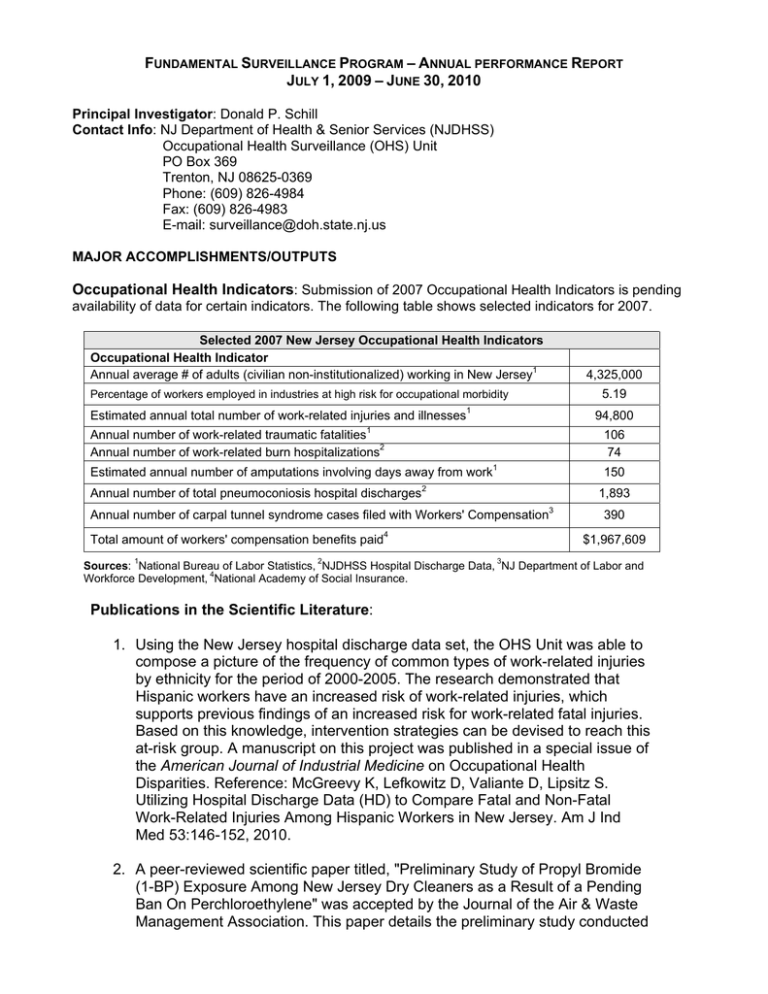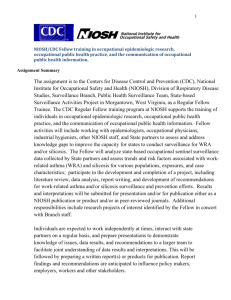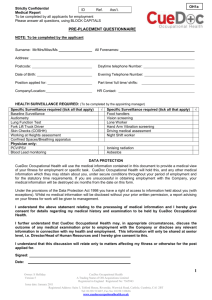F S P –
advertisement

FUNDAMENTAL SURVEILLANCE PROGRAM – ANNUAL PERFORMANCE REPORT JULY 1, 2009 – JUNE 30, 2010 Principal Investigator: Donald P. Schill Contact Info: NJ Department of Health & Senior Services (NJDHSS) Occupational Health Surveillance (OHS) Unit PO Box 369 Trenton, NJ 08625-0369 Phone: (609) 826-4984 Fax: (609) 826-4983 E-mail: surveillance@doh.state.nj.us MAJOR ACCOMPLISHMENTS/OUTPUTS Occupational Health Indicators: Submission of 2007 Occupational Health Indicators is pending availability of data for certain indicators. The following table shows selected indicators for 2007. Selected 2007 New Jersey Occupational Health Indicators Occupational Health Indicator Annual average # of adults (civilian non-institutionalized) working in New Jersey1 4,325,000 5.19 Percentage of workers employed in industries at high risk for occupational morbidity Estimated annual total number of work-related injuries and illnesses 1 94,800 1 Annual number of work-related traumatic fatalities Annual number of work-related burn hospitalizations2 106 74 Estimated annual number of amputations involving days away from work1 Annual number of total pneumoconiosis hospital discharges Annual number of carpal tunnel syndrome cases filed with Workers' Compensation Total amount of workers' compensation benefits paid4 150 2 1,893 3 390 $1,967,609 Sources: 1National Bureau of Labor Statistics, 2NJDHSS Hospital Discharge Data, 3NJ Department of Labor and Workforce Development, 4National Academy of Social Insurance. Publications in the Scientific Literature: 1. Using the New Jersey hospital discharge data set, the OHS Unit was able to compose a picture of the frequency of common types of work-related injuries by ethnicity for the period of 2000-2005. The research demonstrated that Hispanic workers have an increased risk of work-related injuries, which supports previous findings of an increased risk for work-related fatal injuries. Based on this knowledge, intervention strategies can be devised to reach this at-risk group. A manuscript on this project was published in a special issue of the American Journal of Industrial Medicine on Occupational Health Disparities. Reference: McGreevy K, Lefkowitz D, Valiante D, Lipsitz S. Utilizing Hospital Discharge Data (HD) to Compare Fatal and Non-Fatal Work-Related Injuries Among Hispanic Workers in New Jersey. Am J Ind Med 53:146-152, 2010. 2. A peer-reviewed scientific paper titled, "Preliminary Study of Propyl Bromide (1-BP) Exposure Among New Jersey Dry Cleaners as a Result of a Pending Ban On Perchloroethylene" was accepted by the Journal of the Air & Waste Management Association. This paper details the preliminary study conducted by the OHS Unit which demonstrates 1-BP exposure to dry cleaning workers in excess of five times the American Conference of Governmental Hygienists (ACGIH) threshold limit value (TLV). This work is currently featured on NIOSH Science Blog – 1-BP: A Potential Occupational Hazard. One commenter announced that the California Occupational Safety and Health Standards Board (OSHSB) voted on December 17, 2009 to adopt a 5 ppm Permissible Exposure Limit [8-hour, time-weighted average] for 1BP. A consultant’s report to the City of Philadelphia, PA cited the NJDHSS paper in support of the recommendation to ban 1-BP as an alternative to perchloroethylene in dry cleaning. NIOSH State-Based Occupational Clearinghouse: The OHS Unit has begun compiling information for the NIOSH State-Based Occupational Clearinghouse. All occupational health publications will be included in the clearinghouse: grey literature, peer-reviewed publications, NIOSH-sponsored research articles, and materials that were not funded by NIOSH. The mission of the Clearinghouse is to promote dissemination and use of state occupational health materials. The goal is to improve the CDC's ability to disseminate data and information to state health officers, policy makers, and the public. As a centralized repository of all state occupational health publications, these publications will be easier to locate and access. Additionally, NIOSH will be able to have a complete inventory of publications that were produced through its funding. Occupational Health Surveillance and Intervention Grant Proposals: OHS Unit staff and Program Manager prepared and submitted five competitive project proposals in response to a funding opportunity announcement issued by CDC/NIOSH for State-Based Occupational Health and Safety Surveillance. The proposals build on past work of the OHS Unit, and include expanded and enhanced components aimed at targeting newly emerging hazards and populations at risk, as well as collaborations with new partners and stakeholders. FUTURE ACTIVITIES NJDHSS will continue to collect information and data to generate the occupational health indicators on an annual basis. Utilizing year-specific denominators, we will conduct a trend analysis among selected indicators over a five-year period. This information will be compiled for the annual report and/or a dedicated public health report. The Fundamental Surveillance system will be evaluated against the following characteristics: simplicity, flexibility, data quality, acceptability, sensitivity, predictive value positive, representativeness, timeliness, and stability. EXPANDED SURVEILLANCE – WORKPLACE FATALITY: ANNUAL PERFORMANCE REPORT JULY 1, 2009 – JUNE 30, 2010 Principal Investigator: Donald P. Schill Contact Info: NJ Department of Health & Senior Services (NJDHSS) Occupational Health Surveillance (OHS) Unit PO Box 369 Trenton, NJ 08625-0369 Phone: (609) 826-4984 Fax: (609) 826-4983 E-mail: surveillance@doh.state.nj.us MAJOR ACCOMPLISHMENTS/OUTPUTS New Hazard Alert Targets Marine and Rail Cargo Industry: The New Jersey Fatality Assessment and Control Evaluation (NJFACE) Project developed a hazard alert regarding two workers fatally injured while performing routine maintenance of cargo container lifting devices. The alert is targeted to all workers who handle the loading and off-loading of cargo-container spreaders and lifting frames. The alert was vetted to the NIOSH FACE Program and other expert reviewers and is being finalized. The alert will be issued to companies in the New Jersey marine and rail cargo industry. NJ FACE Collaborations: 1. As part of the School Crossing Guard outreach project, NJFACE is collaborating with the NJ Department of Transportation and the NJ Safe Routes to School (SRTS) Coalition at Rutgers University’s Bloustein School of Planning and Public Policy. SRTS is a federal, state and local effort to enable and encourage children, including those with disabilities, to walk and bicycle to school. NJFACE staff attends the coalition meetings, and are helping draft a guidance document on crossing guard safety to disseminate to their constituents. 2. NJFACE staff collaborated with the NJ Public Employees Occupational Safety and Health Program and OSHA Regional Office to create a Workers’ Memorial Day tribute listing the names, ages, and occupations of the 14 New Jersey public sector workers who were killed on the job in 2008-2009. A large-format poster was created that highlighted New Jersey fatality and injury facts, examples of outreach materials, and research activities conducted by the OHS Unit. The memorial materials were displayed for the public in the Department’s main lobby, and NJFACE staff responded to inquiries regarding the topic. 3. Two NJFACE staff were appointed as Adjunct Professor Faculty at the University of Medicine and Dentistry of New Jersey’s School of Public Health. This provides an opportunity to collaborate on research and outreach projects. A course was offered in spring, 2010, which included a detailed overview of the FACE program and other occupational health surveillance topics. NJ FACE Conducts Follow-up Survey with Police Chiefs: A one-year follow-up survey was developed to evaluate the impact of the School Crossing Guard hazard alert. The follow-up survey was mailed to 534 Police Chiefs. A total of 308 responses have been received (57% response rate) to date. Police Chiefs were asked to provide detailed information on changes made with regards to crossing guard safety training, personal protective equipment, and hazard awareness, as a result of this outreach project. The data are being analyzed. NJFACE has received requests from the Police Chiefs for over 600 additional copies of the alert. Publication in the Scientific Literature: NJFACE conducted trend analysis of 2001-2005 New Jersey hospital discharge data in which fatal and non-fatal work-related injury data of Hispanic workers were analyzed. In the study, hospital admission analyses indicated an increased risk of work-related injuries requiring hospitalization among Hispanic males for work-related falls, motor vehicle incidents, struck by objects, and machine related incidents compared to the US working population. Findings from this study were published in the American Journal of Industrial Medicine’s Special Issue on Occupational Health Disparities. [K. McGreevy, D. Lefkowitz, D. Valiante, S. Lipsitz (2010). Utilizing hospital discharge data (HD) to compare fatal and non-fatal work-related injuries among Hispanic workers in New Jersey. Am J Ind Med 53(2):146 – 152]. Workplace Interventions: The following are fatality investigations that were initiated, investigated, or completed in FFY10: NJFACE ID # Incident Category Case Summary A construction worker fell four stories from a hotel. It was the worker’s first day on the job, which was to perform renovations. A construction worker was installing roof decking at an industrial park building when he fell 40 feet. He was wearing a fall protection harness and retractable lanyard that was attached to a roof anchor. As he fell, the force pulled the anchor from the roof. Owner of a jewelry store was discovered unconscious in a locked restroom. Hazmat responders found a container with cyanide solution and some pieces of jewelry in the restroom. The confirmed cause of death was acute cyanide toxicity. 10-NJ-02 Fall 09-NJ-78 Fall 09-NJ-55 Chemical Exposure 08-NJ-79 Machine A sanitation worker was run over by a garbage truck that had moved forward unexpectedly. 08-NJ-52 Fall A maintenance worker fell 60 ft. from a communications tower while changing out diagonals during a structural upgrade. 08-NJ-03 Explosion A maintenance worker was killed when a large pressure vessel used at a foundry exploded during a leak testing procedure. Four other workers were injured. FUTURE ACTIVITIES New collaborations are planned with NJ OSHA Area Offices and other stakeholders to develop an emphasis on the newly identified NIOSH targets e.g., the energy industry (focusing on alternative energies such as wind, solar, and biodiesel). NJFACE plans to collaborate with NIOSH on a nationwide awareness campaign on crossing guards safety. A second meeting of the NJFACE Hispanic Subcommittee will be held to identify goals and strategies, and to develop and prioritize action items. The FACE Project will be evaluated using a logic model developed for the purpose. EXPANDED SURVEILLANCE – SILICOSIS: ANNUAL PERFORMANCE REPORT JULY 1, 2009 – JUNE 30, 2010 Principal Investigator: Donald P. Schill Contact Info: NJ Department of Health & Senior Services (NJDHSS) Occupational Health Surveillance (OHS) Unit PO Box 369 Trenton, NJ 08625-0369 Phone: (609) 826-4984 Fax: (609) 826-4983 E-mail: surveillance@doh.state.nj.us MAJOR ACCOMPLISHMENTS/OUTPUTS Collaborative Efforts to Prevent Silica Exposure in New Jersey Continue: The OHS Unit is collaborating with NIOSH, OSHA, and New Jersey Turnpike Authority to conduct silica sampling to assess worker exposures to silica and develop a Video Exposure Monitoring (VEM) product for dowel drilling. Dowel drilling (Figure 1) is a task performed during new highway construction (e.g., when a lane is added) or during repair of concrete pavement, and is conducted to insert dowels, which are steel rods used to provide stability between adjacent pavement slabs. The primary exposure to crystalline silica dust occurs during the operation of the dowel drill, but significant exposures can take place during clean-up, especially when compressed air or dry sweeping is used. This project is part of a series of VEM studies to demonstrate the effectiveness of engineering controls used to reduce the amount of worker exposure to airborne crystalline silica dust. VEM is a technique that uses a direct–reading measurement to measure a worker’s exposure while performing a task as it is being recorded on videotape. The VEM product graphically displays real-time exposure levels as an overlay on the video of work tasks (Figure 2). FIGURE 1. Workers Operating Dowel Drills on Bridge Deck 4.4 x REL FIGURE 2. Example of VEM Study for Jackhammering 1.4 x REL ` REL= Recommended Exposure Limit (NIOSH) NJDHSS Silicosis Web Site: – VEM Topic page: http://nj.gov/health/silicosis/njvem.shtml Trade Magazine Articles: OHS Unit staff developed an article for Roads & Bridges, a trade magazine for the heavy highway construction industry. This article outlines the hazards of exposure to crystalline silica dust, provides examples of dusty tasks and their exposure levels, presents silicosis case studies, lists ways to prevent or limit dust exposure, and provides pertinent resources. The magazine has a readership of over 60,000 consisting primarily of contractors, government officials, and consulting engineers. A similar article will be submitted to the Utility Transportation Contractors Association (UTCA) of New Jersey for publication in their newsletter. UTCA is a NJ Silicosis Outreach and Research Alliance member. UTCA currently includes approximately 1,100 member firms active in all phases of heavy, highway, site, utility and environmental remediation construction, in the public and private sectors, throughout the State. FUTURE ACTIVITIES Under the NJ SOAR Alliance, outreach presentations will continue to be conducted using a series of topic-oriented modules that will be developed in collaboration with OSHA and the laborers union. Air sampling for silica, with and without engineering controls, will continue to be conducted in collaboration with the NIOSH Division of Applied Research and Technology to assess the effectiveness of the water-spray and other types of dust control for jackhammering, chipping, saw cutting, and clean-up. The silicosis surveillance system will be evaluated against the following characteristics: simplicity, flexibility, data quality, acceptability, sensitivity, predictive value positive, representativeness, timeliness, and stability. EXPANDED SURVEILLANCE – WORK-RELATED ASTHMA: ANNUAL PERFORMANCE REPORT JULY 1, 2009 – JUNE 30, 2010 Principal Investigator: Donald P. Schill Contact Info: NJ Department of Health & Senior Services (NJDHSS) Occupational Health Surveillance (OHS) Unit PO Box 369 Trenton, NJ 08625-0369 Phone: (609) 826-4984 Fax: (609) 826-4983 E-mail: surveillance@doh.state.nj.us MAJOR ACCOMPLISHMENTS/OUTPUTS Asthma and Cleaning Products Brochure Translated into Spanish: A work-related asthma (WRA) topic brochure, Asthma and Cleaning Products – What Workers Need to Know, was translated into Spanish and posted on the NJDHSS WRA Web site. The URL for the Spanish version titled Los productos de limpieza y el asma: información imprescindible para el trabajador is as follows: http://nj.gov/health/eoh/survweb/wra/documents/wra_cleaning_products_sp.pdf. FUTURE ACTIVITIES OHS Unit staff will continue collaborating with other WRA surveillance states and NIOSH on two peer-reviewed publications: 1) the first paper is titled “Work-Related Asthma by Industry Sector: California, Massachusetts, Michigan, and New Jersey – 1993-2006 and will discuss the findings and conclusions associated with a sector-based analysis of surveillance state WRA data; 2) the second paper will report on the characteristics of confirmed cases of WRA as a result of exposure to various diisocyanates. State-specific case studies will also be included. On-site industrial hygiene evaluations will be conducted at selected workplaces where one or more confirmed cases of work-related asthma have been identified through the surveillance system. Surveillance data will be monitored on an ongoing basis to determine if there is a need to conduct focused outreach interventions for particular industries or asthmagenic agents. The work-related asthma surveillance system will be evaluated against the following characteristics: simplicity, flexibility, data quality, acceptability, sensitivity, predictive value positive, representativeness, timeliness, and stability.


